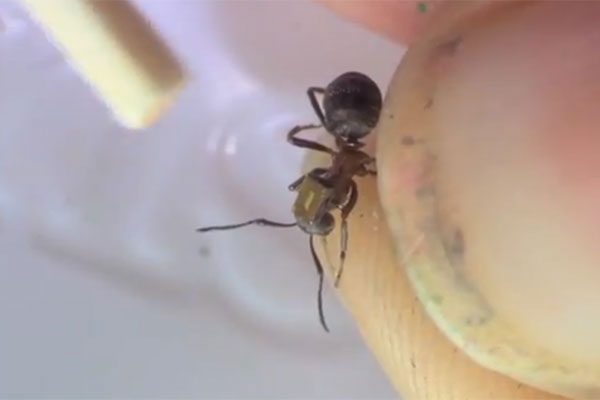Attach chip for ant
British scientists will attach micro-radio chips to the bodies of wood-eating ants in a relic to track their movements.
About 50 million wood ants (Forbica lugubris) live underground in the grounds of Longshaw, Derbyshire, England. These are the biggest ant in this country. The length of worker ants can be up to 10mm. Their nests are connected by countless tunnels. They raise aphids to get the honey drops - the food of the ants. Ants eat wood self-defense by spraying formic acid - compounds with a sour smell like vinegar.

An ant eat wood in the relics of Longshaw, Derbyshire county, England. (Photo: Livescience)
Samuel Ellis, a York University biologist in England, and colleagues wanted to know how wood-eating ants interact with each other. So they will attach tiny radio chips to the body of about 1,000 ants in the ruins to track their movements, Livescience reported.
'Each chip will act as a barcode. It helps us distinguish each ant. You can identify any ant that moves anywhere and the interaction between ants to create the common behavior of the whole herd , 'Ellis said.
The results of the study will help conservation workers in the Longshaw, Derbyshire, and British ruins manage the relics more effectively. Longshaw is a valuable relic of natural and archaeological landscapes. Wood-eating ants are one of the threats to Longshaw. But if you understand the needs and behavior of ants, the team hopes they will find a suitable way to protect the site.
- Attach the chip to the bee
- Attach the chip to the brain to help people with polio move themselves
- Proposing not to attach devices to monitor Sword Lake Turtle
- Successfully manufactured the first optical-electronic chip in the world
- Attach the dog chip to the national scale
- Development of RFID chip 'not hackable'
- Chip 'pump' drug needles
- Attach the file that gmail does not send
- Research smart chip generation for phone learning
- Chip is self-recovering when broken
- Alibaba launches 'super chip AI' that processes 78,500 images per second
- IBM announced optical chip breakthrough
 Why do potatoes have eyes?
Why do potatoes have eyes? 'Tragedy' the world's largest carnivorous life: Death becomes ... public toilet
'Tragedy' the world's largest carnivorous life: Death becomes ... public toilet Tomatoes were once considered 'poisonous' for 200 years
Tomatoes were once considered 'poisonous' for 200 years Detecting microscopic parasites on human face
Detecting microscopic parasites on human face